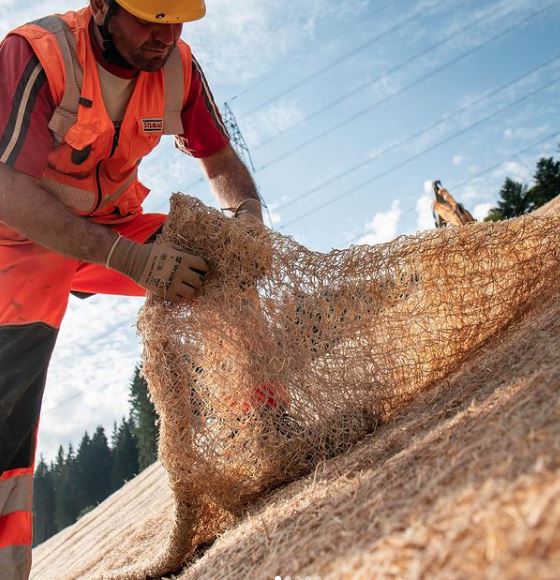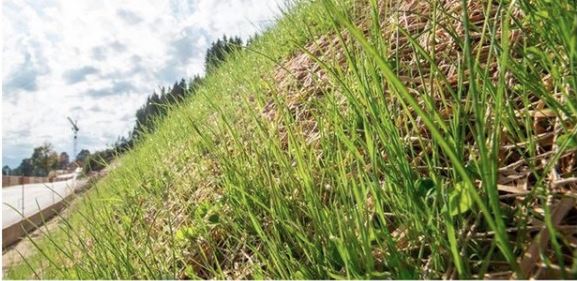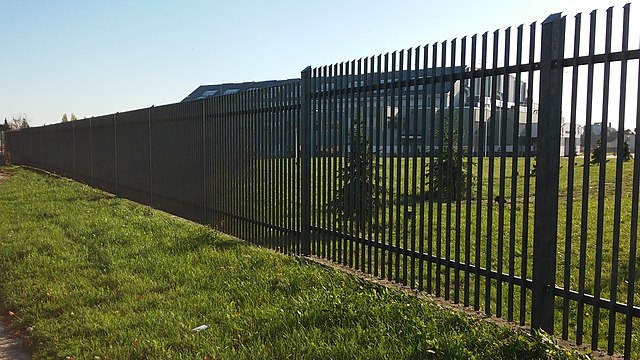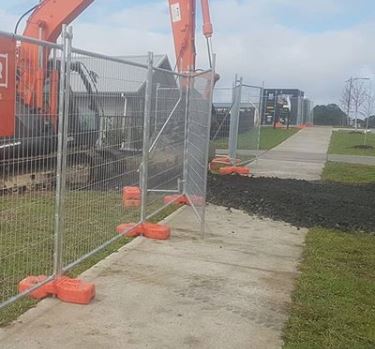What is an erosion control blanket?
An erosion control blanket is a blanket of synthetic or natural fibers to protect soil from the erosive impact of rain and water flow, typically on slopes and in channels. Erosion can be the result of rainfall, wind and severe weather.
These products act like a mulch by helping to retain moisture and allow for more reliable establishment of vegetation. By covering areas of open land with these mats, you can help prevent soil shifting and promote new plant growth. Erosion control blankets are also sometimes referred to as Rolled Erosion Control Products, erosion control fabric, mats, netting and blankets. These all refer to materials applied to the soil to keep it in place.

Native vegetation should be installed with erosion control or soil retention fabric because the blankets only address surface erosion and most are designed to break down over time. Native plants have an extensive and varied root system that will prevent both surface and subsurface erosion for the long term. These products can be used to prevent slope erosion, avert stream channel scouring, and stabilize shorelines until native vegetation establishes.
There are many different types of erosion control blankets, some that are synthetic and some that are natural as well as a blend of both. These blankets can be made out of straw, coconut fiber, aspen fiber, jute, and polypropylene (plastic). Most of these blankets can be bought in many sizes. Common ones are 80 to 100 square yards. Most of these are rolled up and cut into widths ranging from 3 to 8 feet wide.
Erosion control blankets are a good solution to use on steep slopes, above ditches, beside driveways and on construction sites. They can be used with or without a retaining wall as part of your system.
Types of Erosion Control Blankets
Open weave vs. continuous fiber products
Erosion fabrics come in two forms: woven netting with open spaces, and blankets of continuous fibers attached to mesh.
The mesh material may be natural or synthetic, and some synthetic mesh may be photodegradable.
Fibers may be stitched to one mesh layer or sandwiched between two. Continuous fiber blankets cover the soil surface completely, and are usually used on steeper sites or in drainage channels.

Natural vs. synthetic fibers
Natural fiber mats are made from coir (coco matting erosion control), jute (fibers from the plant genus Chorchorus), hay mats, straw or excelsior (fine wood fibers, usually aspen) or a combination of these products. We don’t recommend excelsior because the fibers may come from intact forests.
Straw decomposes the quickest, lasting only one season, and works best for less steep slopes and lower flows. Coir lasts longer than jute. Manufacturers can tell you the functional life of particular products.
Synthetics are unnecessary as long as natural fibers are available. Synthetic geotextiles are more frequently used as part of a permanent stabilization structure, such as soil lifts. Synthetic weed barriers often require removal, which can disrupt native plant establishment.
Jute Netting
Made from the natural fiber jute, this netting is used as an erosion control device alone or used to hold together other erosion control materials.
Fabrijute Netting
This netting is made entirely from plastic, it mimics natural fibers. Netting like this is used to hold together erosion control blankets or just as erosion control itself.
Straw Single Synthetic
This netting is made from straw and held together by a single layer of synthetic netting. This is much more effective than diy straw wattle.
Straw double jute net
Made from ordinary straw, this is held together by a double layer of jute netting.
Straw double synthetic
Made from ordinary straw it is held together by a double layer of synthetic netting.
Coir Double Jute Blanket
Made from coconut fiber it is held together by a double layer of jute netting.
Coir Double Synthetic Blanket
Made from coconut fiber it is held together by a double layer of synthetic netting
How long will an erosion control cloth blanket last?
The type of blanket you select will depend on how long you want it to last in the environment. There are accelerated products that will have a short functional longevity. These blankets are made with agricultural straw and a biodegradable net that are sewn together. If the blanket should last for up to one year, there are thicker options made with the same material, or wood shavings and natural fibers. Extended length blankets are intended to protect an area for up to 2 years. These are made to be more substantial and combine materials like straw, coconut fibers, polypropylene nets and UV stabilized thread. Permanent blanket options are also known as turf reinforcement mats. These are made strong enough to withstand tougher conditions on slopes, coastlines, river banks and high-flow channels. Many other forces account for determining the lifespan of an erosion control blanket such as climate and overall weather patterns.
When should you use erosion control blankets?
Factors in the selection of erosion and sediment control blankets include soil conditions, steepness and length of slope, sheer stress, and type and duration of protection needed to establish desired vegetation. Products are available for a variety of uses and longevity, typically from 3 months to 36 months to permanent applications. Follow Manufacturer’s specifications in order to select the appropriate type of blanket to lay on grass.
How to install erosion cloth blanket
The type of ECB shown on the plans should be installed immediately after completion of a phase of grading and/or seeding. Follow manufacturer’s specifications for installation, particularly noting requirements for check slots, fastening devices (staples), and the need for firm contact with soil.
It is relatively easy to install erosion control blankets. Making sure the water moves over the top of the blankets is the most important thing. You must ‘key’ it into the slope by digging a swale, a small trench on contour along the top of the slope. Lay the top end of the material into the trench to line it. Fold the top edge to make a secure seam and tack it in using staples. Then fill in the trench to the previous soil level. The edge of the blanket that is upwind needs to be overlapped underneath the blanket next to it. This will ensure the soil erosion blanket will stay in place.
Proper installation is critical to success. In order to work, erosion fabrics must have continuous contact with the soil; fabric stretched over voids in the soil will not prevent underlying erosion. It’s best to install them over areas that are as smooth as possible. These products are especially difficult to install properly in areas with down wood or uneven or rocky topography. Mats are usually installed with galvanized landscaping staples (6” staples are sufficient for most applications). Biodegradable corn-based or wood stakes may also be used.
Potential Concerns With Using Erosion Control Blankets
Mesh in continuous fiber fabrics have raised concerns with wildlife conservationists because they may entangle wildlife. Mesh-caused injury and mortality to snakes has been documented. To reduce wildlife impacts, new mesh designs have been developed that allow the threads to move so the openings can expand. Even continuous fiber fabrics may not suppress aggressive weeds, and the mesh may hinder weed removal efforts. Erosion control fabrics do not prevent erosion from sub-surface forces, and may provide a false sense of security. Natural fiber mesh is more biodegradable than synthetic, but the cost is higher.
Maintaining the area covered with an erosion control blanket
Inspect every week and within 48 hours after every rain event that causes stormwater runoff to occur on-site until adequate vegetation is established. Repair erosion and/or undermining at top of slope. Repair undermining beneath blankets. Pull back the blankets, fill and compact eroded area, re-seed and then firmly secure the blankets. Reposition or replace blankets that have moved along the slope or have been damaged.
During the first year after installation, mats should be inspected every 2–3 months for good mat-to-soil contact. Also inspect for signs of the mat inhibiting plant material at the base. Mats may also inhibit species that spread by runners. Once individuals are established, the mat can be cut away to allow more room for spread.
Should an erosion control blanket ever be removed?
If project goals are factored in when selecting a natural-fiber product, the mat should break down in situ, in the appropriate time frame, and removal will not be necessary. Erosion control blankets are typically left in place and designed to degrade over time.
Need Erosion Control Blankets On Your New Jersey Property?
Call 732-370-0291 or Contact Us Now
Frequently Asked Questions
Q: What is erosion control matting?
A: Erosion control matting is a type of material that is used to help stabilize soils and prevent erosion. It is typically made from natural fibers or coir, and can be used on slopes, banks, and other areas where there is a risk of erosion. Matting can help to protect the soil from water and wind erosion, as well as improve its ability to hold onto moisture. It also helps to keep seeds in place so they can germinate and grow into plants. There are a variety of erosion control products on the market, and they can be used for both small and large projects.
Q: What are concrete erosion control mats?
A: Concrete erosion control mats are specially designed products that are used to help control and prevent soil erosion. There are a number of different types of concrete erosion control mats available on the market, each with its own set of advantages and disadvantages. The most common type of concrete erosion control mat is made from expensive, high-strength concrete that is textured to provide extra traction. Concrete erosion control mats typically have a lifespan of around 20 years or more, making them a relatively long-term solution to soil erosion problems.
Q: Can I use grass mats for erosion control?
A: Yes. Grass mats are effective for hillside erosion control. They work by trapping soil and sediment on the surface of the mat, which reduces the amount of material that can be carried away by wind or water.
Q: What is the average erosion control blanket pricing?
A: There is quite a range in erosion control blanket pricing, depending on the specific product and its features. Generally speaking, you can expect to pay anywhere from $0.10 to $0.30 per square foot for an erosion control blanket. Some of the factors that will affect the price include the type of material (woven vs. non-woven), the weight or thickness, and any special features such as UV protection or hydrophobic properties. In most cases, it’s best to work with a professional landscaping company or erosion control specialist to find the right product for your needs and budget.
Q: What is jute erosion control cloth?
A: Jute erosion control cloth is a biodegradable fabric made from natural jute fibers that are used to stabilize soil and prevent erosion. Jute landscape fabric is commonly used on construction sites, in parks and gardens, and along highways and roads. Jute mesh is effective at preventing soil loss due to wind and rain, and it can be used to cover slopes, embankments, ponds, and other areas that are prone to erosion.
Q: What is fiber roll erosion control?
A: Fiber roll erosion control is a method used to control erosion by inhibiting plant growth. This is done by applying a thin layer of plastic or other material to the ground which restricts germination and photosynthesis. The idea is that pioneer species will be denied vital resources needed for growth, allowing slower-growing, more long-lived climax species to outcompete them. This; in turn, stabilizes soils, reduces runoff and sedimentation, and leads to improved water quality downstream. While this may seem like a sound plan, it has been met with some criticism. Most notably, it can be quite costly and labor-intensive to properly install and maintain a fiber roll system.
Q: What is a vegetated concrete mat?
A: A vegetated concrete mat (VCM) is a type of green infrastructure that uses vegetation to stabilize and reinforce soil. VCMs have been used for a variety of purposes, including anti erosion matting, stormwater management, and slope stabilization.
Erosion control is one of the primary functions of a VCM. The vegetation helps to hold the soil in place, preventing it from being washed away by rain or wind. Stormwater management is another key benefit of VCMs. By dissipating stormwater runoff, VCMs can help to reduce flooding and property damage. Finally, VCMs can also be used to stabilize slopes and prevent landslides.
Q: What are rubber mats for erosion control?
A: Rubber mats for erosion control work to prevent soil from being washed away due to rainfall or wind. The mats are placed in strategic areas, such as by a river’s bank, to help keep the soil in place and protect the land from erosion.
The mats are made of durable rubber and are designed to withstand extreme weather conditions. They also allow water to permeate through them so that the ground beneath remains moist and does not become dry and cracked. By using rubber mats for erosion control, landowners can minimize the amount of topsoil that is lost each year, which helps keep the land healthy and productive.
Q: How to stop driveway erosion?
A: There are a number of ways to stop driveway erosion. One is to make sure that your driveway is graded so that water drains away from it. Additionally, you can use gravel or other materials to create a surface that will not erode as easily as concrete or asphalt. Finally, you can seal your driveway to prevent water from seeping in and causing erosion.
Q: How to prevent erosion on sloped yard?
A: There are a few ways to prevent erosion on a sloped yard. One way is to plant vegetation that will help stabilize the soil, such as grasses, shrubs, or trees. You can also build a retaining wall or fence to keep the soil in place. Finally, you can use mulch or rocks to cover the soil and prevent it from washing away.
Additional Resources
- Soil Erosion and Sediment Control Strategies for NJ Residential Construction
- What is a retention pond and why is maintenance important?
- This article discusses The Benefits of Erosion Control Tubes and Silt Socks
- How does Vegetation Help Stabilize Slopes and Prevent Erosion?
- Silt Fence Best Practices for Stormwater Management
- Construction Sitework: Everything You Need to Know
- Where Does Stormwater Runoff Go?
- Types of Soil Erosion and Mitigation Strategies
- This is a great article about What is Soil Stabilization in Road Construction.
- Here’s a great post if you’re looking for information about Dealing With Foundation Drainage Issues.
- This is a helpful article about How Is Straw Wattle Used For Erosion Control?
- Do You Need a Portable Temporary Fence for Your Construction Site?
- How to Estimate Sitework and Sitework Costs



